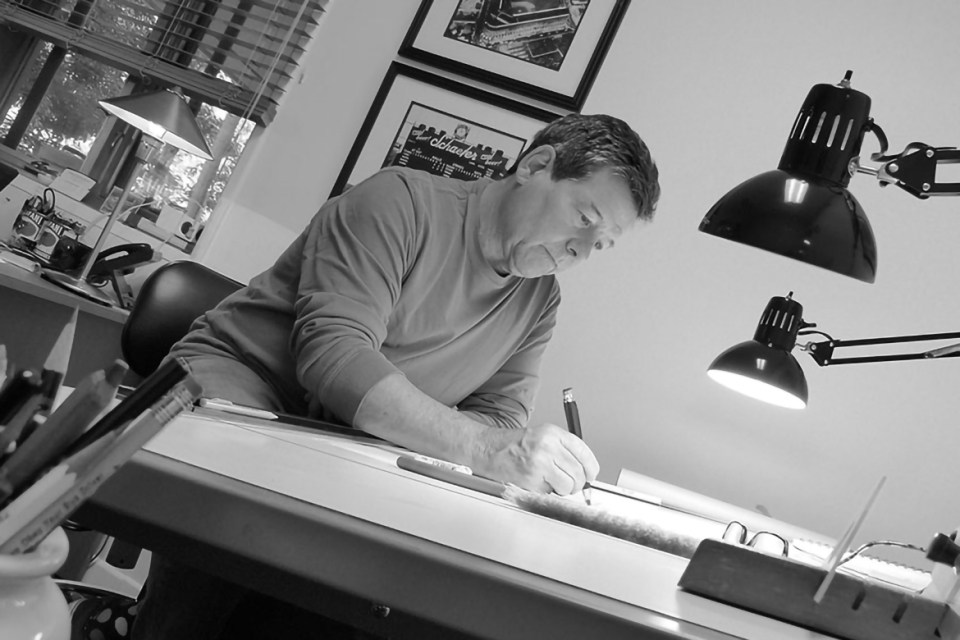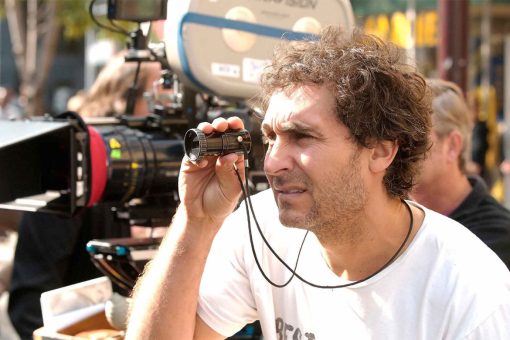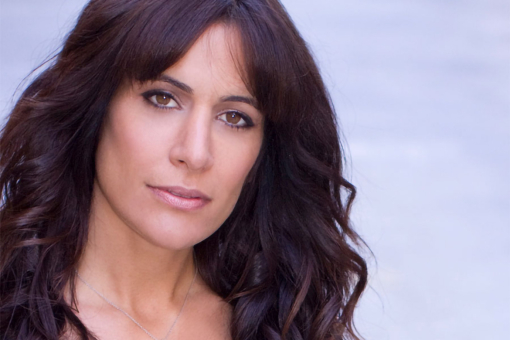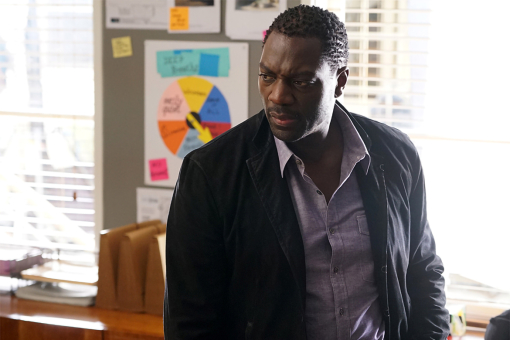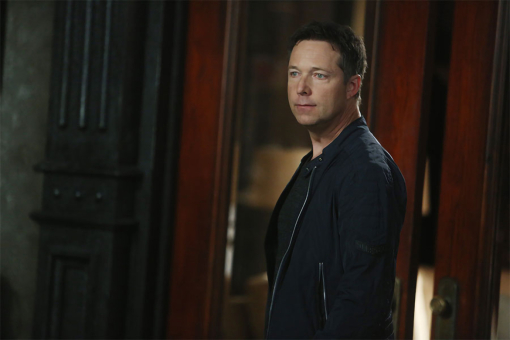Visual storytelling is a collaborative medium.
It takes hundreds, sometimes thousands, of people working together to create even just a few seconds of a film or television show. Those people are organized into departments, most of which are further sorted into more specialized departments.
The Art Department spans multiple artistic disciplines and is responsible for creating the overall visual environment of a show. Art Directors, Set Designers, Graphic Designers, Concept Artists, Art Department Coordinators, Set Decorators, Buyers, Set Dressers, Prop Masters, Prop Makers, entire construction crews, and assistants are all under the umbrella of the Art Department.
And at the head of it all is the Production Designer creating the physical environment for a written story.
Steven Jordan did not begin his career as a Production Designer; in fact, the entertainment industry was not the first path upon which he endeavored.
Despite growing up with a father who worked in commercials as an Assistant Director and a mother who was a Script Supervisor, the Manhattan native, adding layers to his own life, set out for a career in music.
"I got involved in music in Junior High School. I was one of a thousand 13-year-olds that wanted to play the drums, but the band director handed me a bassoon instead. And I looked at the thing in horror."
He laughs, "It took me three days to learn how to assemble it."
"I didn't know anything about music, couldn't read music, but he handed me the bassoon and I learned how to play and a year or two in, I was really liking it."
At the suggestion of his band teacher, Jordan began taking private lessons, "My mother phoned a man who was, at the time, the principal bassoonist at the NY Philharmonic and he agreed to take me on knowing I was an absolute beginner.
"It was tough; he used to poke me in the face with a pencil because I was puffing my cheeks, but he did prepare me for an audition for the school of performing arts. That's really where I started getting serious about music; that was the same school that Fame was based on."
By the time it was time for Jordan to start thinking about college, the entertainment industry and the art department weren't even a glimmer: music was his only focus.
He auditioned for multiple prestigious musical conservatories including The Manhattan School of Music, Hart College of Music, North Carolina School of the Arts, and Juilliard. Receiving acceptance letters for all of them, it was the latter that Jordan jumped at and never looked back.
Surrounding himself with the best of the best in music, dance, and performance art, Jordan spent the next five years studying at Juilliard. His peer group included Kevin Kline, William Hurt, Robin Williams, and his future wife, Nancy.
It was also in this time that he was introduced to a more visual aspect of the arts.
Jordan explains, "Somewhere around my second or third year, I got a job in the scene shop. I'd work there on Saturdays for like $2.00 an hour for spending money."
The carpenters and painters who work in the scene shop collaborate with designers and directors to create scenery for every production at the school.
"It was just amazing to watch these guys work. I really started to enjoy being around all of it and by the time I was going for my Masters, I was spending more and more time in the scene shop."
But even with this newly discovered fondness for the sets and scenery he witnessed being created, Jordan continued to pursue his love for music after graduating Juilliard.
He freelanced in New York City, playing bassoon in various orchestras and other music groups before landing a job with the National Ballet of Canada.
Jordan remembers, "It was a big-deal-gig; a touring gig across Canada with Fernando Briones and Karen Kain, who was the prima ballerina at the time, so I was very excited. We did all the war horses: Sleeping Beauty, Swan Lake, Coppélia."
"But one evening, I looked around the pit and saw all these guys in their 40s and 50s who just looked miserable…and I wasn't sure that this was what I really wanted to do."
He digs a little deeper, "It was a very lonely existence you know, you're alone in your hotel room, you practice all day alone, you go to the theater, you play the show, and go back to the hotel room. Sure, the collaboration is amazing when you're playing with your colleagues, but comparatively, that part is short lived.
"Juilliard was a very worthwhile education. It was all about discipline; that was the bottom line and when I transitioned into this business I feared leaving music would be something I'd regret for the rest of my life."
That discipline that became so ingrained, such a natural part of his workflow, would guide Jordan in his next career.
"I finished the tour, came back to New York, and I happened to get a call: someone needed a guy to drive a Costume Designer around the city for a commercial; basically I'd sit in the car in front of Bloomingdales while she shopped for three or four hours, then I'd take her to the next stop.
"So I did that and then I started getting more phone calls and began working a little bit in props."
Jordan recalls his first experience on a film set, "I got a phone call one day from the head of the prop department for a two-day gig in Bay Ridge Brooklyn. I had never been on a feature film set, I didn't know what a call sheet was, they just gave me an address.
It was a 7AM call and I showed up and they gave me a bee burner…it was charcoal and rosin, literally what bee keepers use, and I went to the top of this two-story set and sat next to a Mole fan. I was told to just kept the bee burner going all day.
They spent the first three hours lighting, then with a hit of a switch the floor started pulsating; I'm up there having no idea what's going on, just pumping this incense smoke into the atmosphere, and then the call for rehearsal came and I see John Travolta in his white suit with a disco posse walk in."
Steven Jordan was in the room, with no regrets.
After a couple of years working in props, mostly on commercials in and around New York City, he began to transition into set decoration.
"It was a pretty big leap at the time because the industry was so different in that we didn't have the tools that are so readily available today. No cell phones, no Internet, no computers; the technology was just archaic compared to today; it was all leg work."
As a Set Decorator, responsible for finding the proper furniture, drapery, and other pieces of set dressing, he was exposed to and working with Production Designers from all walks of life. But it was Mel Bourne who took Steven Jordan under his wing.
"Mel and I had met on commercials, but he had already done Annie Hall and Manhattan. He was one of my big mentors and he phoned one day and the next thing I know, I'm Mel's Set Decorator on a feature called Stardust Memories."
"It was an interesting film for me because I'd never worked in black and white, not to mention, I'd never worked with Woody Allen." Jordan pauses in reminiscence, "Gordon Willis was the Cinematographer…it was the kind of thing where you have to pinch yourself."
From there, he segued into more feature film work as a Set Decorator (Arthur, Still of the Night, Moscow on the Hudson) and then stepped up to Art Director (Enemies: A Love Story, Scenes from a Mall, Home Alone 2: Lost in New York).
Making difficult decisions with conviction is imperative to anyone in charge of other people, Production Designers in particular. Ambition and the discipline from his Juilliard days compelled him forward, the next strata being production design; and to further prepare himself for that, he went back to school.
"While I was set decorating features in New York, I was going to night school to learn the craft of art direction and design. It was an interesting school called the Studio and Forum of Stage Design. That's where I really learned the rudiments of the job: I took courses in drafting, I learned to break down scripts, how to talk to a director, all that."
Eventually, the time came when Jordan stopped taking calls to decorate and was ready and willing to move up to lead the Art Department.
He got himself an agent and soon after landed his first film as a Production Designer: Tony Bill's Untamed Heart, followed closely by Daniel Stern's directorial debut, Rookie of the Year.
The next eight years brought an onslaught of feature film work: The Brady Bunch Movie, Clueless, Wild America, Good Burger, BASEketball, A Night at the Roxbury, Never Been Kissed, Loser.
Steven Jordan was becoming the comedy guy; somewhat different strokes from the dramatic heavyweights who originally helped open his eyes: Guzman, Benton, Bertolucci, Storaro.
"I was honestly getting a little bored with it; I really wanted to get back to something a little juicier. I was tired of working in primary colors."
Jordan, still based in New York and commuting to friends' couches in Los Angeles to work in film, was next offered the opportunity to design the NBC drama, Third Watch (based in New York).
"At that time there was a bit of a stigma attached to television, it was almost frowned upon, but I did Third Watch for five or six years and I kind of liked the lifestyle."
"The other thing that happened on that show was Nancy started working with me (as Art Department Coordinator). All the years I'd come out to LA, she was at home keeping the fire going, and it was very hard to be away, but with Third Watch, the kids were grown, and we started working together."
It wasn't until his next television job that the Jordans decided to put roots down in Los Angeles.
"I came out and met with Larry Trilling, Jason Katims, and Dylan Massin to do a series called Parenthood. They were gearing up for the series at Universal."
Parenthood ran for six seasons and during the last two seasons Jordan found himself doubling up on shows, simultaneously designing the Katims' created show, About a Boy.
"Television has been very rewarding. I love the alarm clock every morning and after close to 40 years of doing this, I can say without hesitation that I truly enjoy going to work every day."
Today, Steven Jordan is happily continuing his work in television as the Production Designer on NBC/Universal's Good Girls.
"Jenna Bans and Bill Krebs are an absolute pleasure and we have developed a lot of trust; that's very important to me."
"I've learned over the years that for me to be successful in my job, I have to enable everyone else; I can't design sets that people can't light, that directors can't stage. If they can't do their job, I've failed at mine."
"Production design operates on so many levels, it's almost a jack-of-all-trades job and it's all based on character building: you read the script, get a bead on the characters, and for me what always helps is understanding that you're setting a tone and it's not your vision alone, but you are bringing something to the table.
"Designers bring a visual interest for everything; you can't just build white boxes for people to work in."
"'Layers of life' was something I learned very early on. You can put out the most magnificent textiles and carpets and furnishings, but until you see a coaster on the table, nobody lives there."

